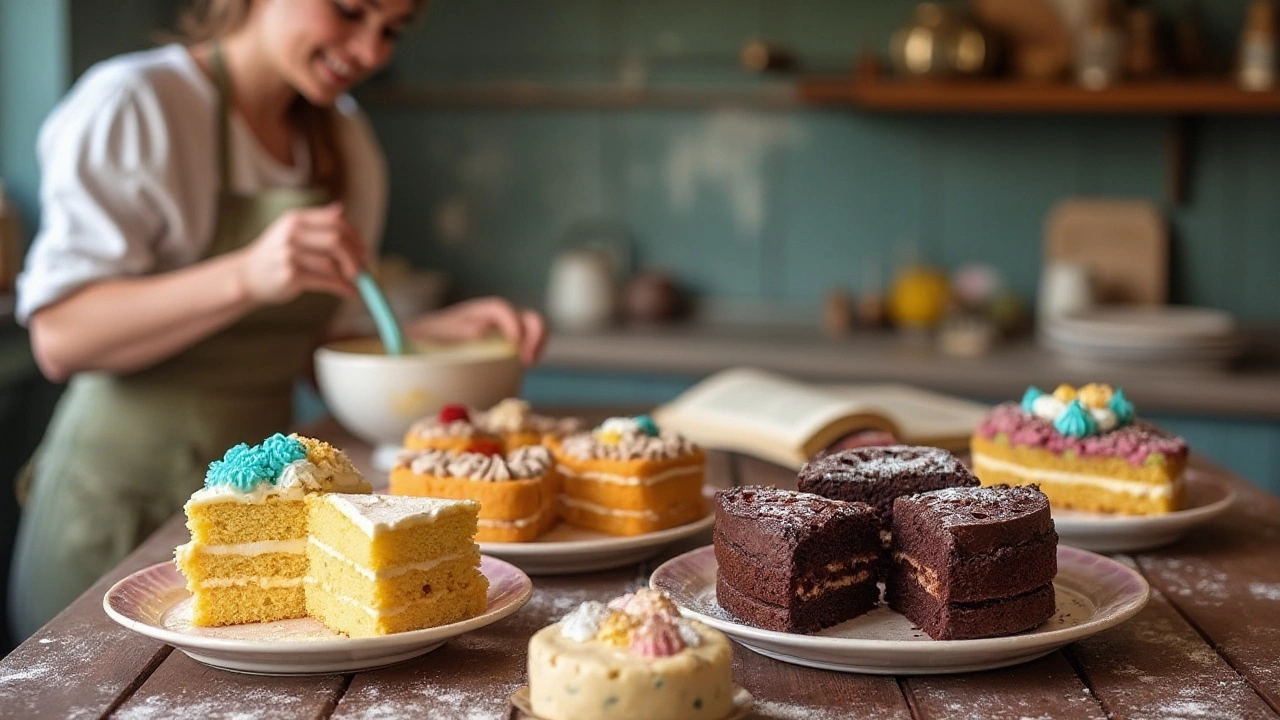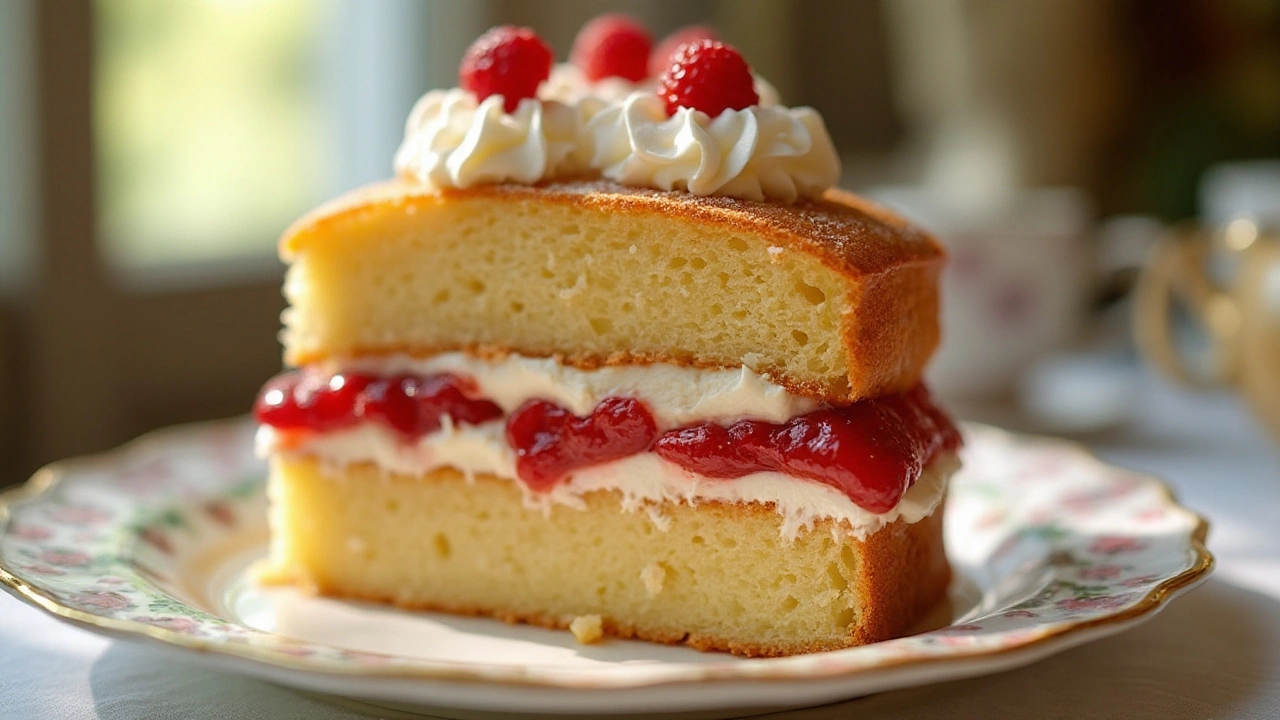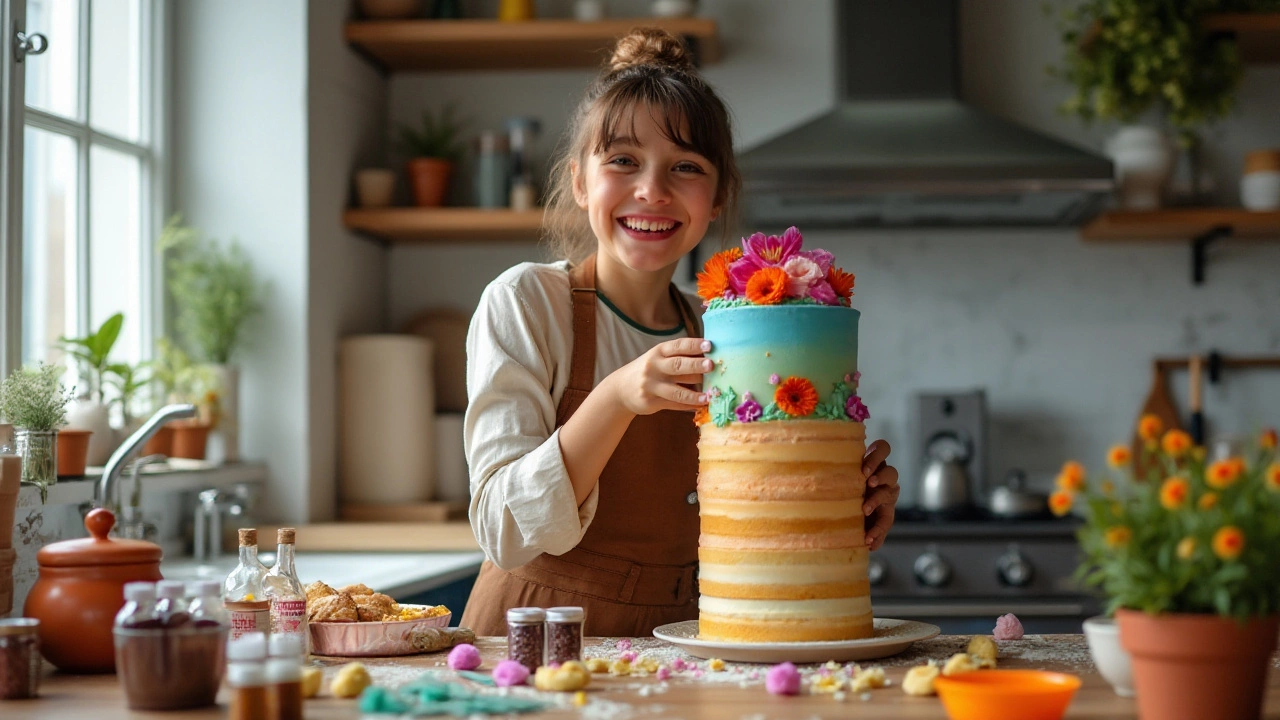
There's something truly delightful about the process of baking a cake, from the initial mixing of ingredients to that magical moment when you take the beautifully risen creation out of the oven. Cakes are at the heart of celebrations, each layer and flavor telling a story and bringing joy to the gathering.
In this guide, we're diving into some of the most delicious cake recipes that are sure to satisfy even the most discerning sweet tooth. Whether you’re a seasoned baker or just starting your journey, you'll find valuable tips and inspiration here to create cakes that are both stunning and delectable.
- The Art of Baking: Essential Tips
- Exploring Popular Cake Varieties
- Unique Flavors and Ingredient Combinations
- Techniques for Perfect Cake Textures
- Decorating and Serving Suggestions
The Art of Baking: Essential Tips
Baking is both a science and an art, a perfect blend of precision and creativity. At its heart, successful cake baking lies in understanding the interaction of ingredients and mastering techniques that ensure every bake turns out just right. One of the most fundamental tips is to measure your ingredients accurately. Baking depends heavily on ratios and quantities, where even a small error can affect the final result. Use a kitchen scale for accuracy, especially for dry ingredients like flour and sugar, which can be easily mismeasured when using cups.
The temperature of your ingredients can also make or break a recipe. For most cake recipes, having butter and eggs at room temperature is key for an even batter and proper aeration, leading to a tender crumb. Plan ahead to allow refrigerated ingredients to come to room temperature naturally, which can usually take about an hour. If you forget, you can gently warm butter in the microwave in short bursts, and place eggs in warm water for a few minutes, but avoid overheating them.
"Baking is largely about patience and encouraging those processes of chemistry" - Mary Berry
When mixing, the technique matters just as much as the ingredients. Over-mixing can cause gluten to develop, which is desirable in bread but can make cakes tough and dense. Mix your batter just until the ingredients are combined and a few lumps remain; they will often bake out during cooking. Using the right tools also matters; hand mixing for lighter batters and stand mixers for denser ones can make a noticeable difference.
To ensure even baking, it's crucial to prepare your baking pans properly. Grease your pans with butter or non-stick sprays and consider lining the bottom with parchment paper for added insurance against sticking. Additionally, preheating the oven is not just a suggestion; it is imperative for cakes to rise properly. Most cakes bake best at a 350°F (180°C), but always follow your recipe's guidance. If possible, invest in an oven thermometer to ensure your oven is at the correct temperature.
Cakes are delightfully versatile, and experimentation can lead to delightful surprises. Don’t shy away from adjusting flavors or adding unique ingredients—try zesting some citrus fruit, or incorporate a hint of your favorite spice to turn a classic recipe into something truly special. The addition of natural extracts or flavor powders can elevate a standard vanilla cake into a gourmet delight. Just remember, when trying new ingredients, contemplate how they complement the existing flavors and textures in your cake for a balanced result.
Exploring Popular Cake Varieties
When it comes to cake varieties, there is a rich tapestry of options steeped in cultural heritage, regional flavors, and timeless tradition. One of the most beloved and versatile types is the classic Victoria sponge, which remains a staple in British baking. Known for its simplicity and elegance, this cake typically consists of two light and airy sponge cakes that sandwich a layer of jam and whipped cream. Traditionally, raspberry jam is used, although strawberry jam is also popular. Loved for its texture and balance of sweetness, the Victoria sponge manages to capture the hearts of everyone, from home bakers to professional chefs.
Moving across the pond, the American chocolate cake varies in its recipes, but it's renowned for its moistness and rich, indulgent chocolate flavor. Whether it's a devil's food cake or a simple chocolate layer cake, chocolate cakes are celebrated for their diversity in texture and taste. They can go from dense and fudgy to light and fluffy, demonstrating chocolate's versatility in baking. According to the renowned culinary expert Julia Child, "A party without cake is just a meeting," highlighting how integral cakes are to celebrations and gatherings. Chocolate's adaptable nature allows for many variations, letting bakers infuse their creations with ingredients like coffee, caramel, or even chili for an unexpected kick. Delicious cakes like these offer a canvas for creativity, ensuring they remain a favorite choice for many.
The red velvet cake, with its distinctive bright red hue, is another favorite that's loved across the globe. Often associated with special occasions, its unique color can be attributed to a chemical reaction between cocoa powder and acidic ingredients like vinegar or buttermilk. Some bakers also use food coloring to enhance the red shade. The flavor profile of red velvet cake is subtly chocolatey, with a slight tang that pairs beautifully with the smooth, creamy frosting that typically adorns it, usually cream cheese or ermine frosting. A secret to achieving that velvety texture is to incorporate a small amount of vinegar, which reacts with the baking soda, leading to an especially soft crumb.
Beyond these well-known varieties, the world of cake recipes is vast and ever-evolving, with a host of regional specialties enriching the lexicon. Tiramisu, an Italian favorite, doubles as both a cake and dessert, featuring layers of coffee-soaked ladyfingers, mascarpone cheese, and cocoa powder. The name ‘Tiramisu’ means ‘pick me up’ or ‘cheer me up’, capturing the spirit of this delightful creation. In Japan, the airy and less sweet Japanese sponge cake, or Castella, brings a delicate nuance to traditional European cakes, with its fluffy texture and subtle sweetness derived from using more eggs and less sugar. The adaptability of cakes means there's always something new to explore, from cultural favorites to modern innovations.

Unique Flavors and Ingredient Combinations
Crafting a memorable cake often starts with stepping outside the traditional boundaries of vanilla and chocolate. Embracing unique flavors and ingredient combinations can elevate your cake from merely delicious to utterly unforgettable. Imagine the tangy burst of passion fruit mingling harmoniously with creamy coconut layers, creating a tropical escape in every bite. This delightful pairing not only brings exotic notes but also offers a visually enticing presentation with its bright and inviting hues.
In the realm of inventive cakes, the fusion of sweet and savory elements is gaining popularity. Consider the intriguing combination of rosemary and olive oil. These ingredients, typically reserved for savory dishes, bring an aromatic depth and moist texture to a cake that intrigues the palate. Paired with a hint of lemon or orange zest, it introduces a dash of refreshing citrus, making each slice a symphony of flavors. Such inventive creations can both surprise and satisfy those who appreciate a twist on classic baking.
"The best way to find yourself is in the service of others," says Mahatma Gandhi, reminding us that even a simple cake can serve to connect us through uncommon taste experiences.
For adventurers in the kitchen, the use of spices like cardamom, saffron, and star anise offers intriguing ways to layer flavors. Cardamom, with its naturally sweet and warm notes, pairs exceptionally well with pistachios and rose water to create a cake reminiscent of Middle Eastern desserts. Saffron, prized as much for its golden hue as its delicate flavor, is wonderful in simple sponge cakes or pound cakes where it can truly shine. Star anise, often employed in holiday spiced cakes, provides a hint of licorice that can be surprisingly delightful when combined with chocolate or pears.
An array of unconventional ingredients such as matcha, black sesame, and yuzu are carving out spaces in modern cake-making. Matcha, a type of green tea powder, imparts an earthy, slightly bitter flavor that balances beautifully with white chocolate or red bean paste. Similarly, black sesame seeds not only add a dramatic visual appeal but also bring a nutty, slightly sweet taste that complements flavors like vanilla and almond. Yuzu, a citrus fruit from East Asia, adds a zingy freshness that can uplift any cake, particularly those with denser textures.
One can't discuss delicious cake recipes without mentioning the role of alcohol. From rum-soaked raisins to amaretto-infused batters, spirits can deepen the richness of flavor profiles. Incorporating a splash of bourbon in a pecan cake enhances its nutty warmth, while a champagne-infused frosting adds sophistication and a celebratory touch to fruit cakes. For those seeking a non-alcoholic alternative, coffee, and tea are excellent choices. A rich espresso can intensify a chocolate cake's depth, while chai tea offers a blend of spices that can transform a simple sponge into a fragrant delight.
With such a diverse palette of flavors and ingredients available, bakers are limited only by their creativity. By daring to experiment with these unique combinations, one can craft cakes that are as much a feast for the senses as they are for the taste buds. Whether trying something entirely new or adding a twist to a beloved classic, these bold flavors promise to make every baking endeavor a delicious adventure.
Techniques for Perfect Cake Textures
Achieving a cake with the perfect texture is a blend of science, art, and a fair hint of patience. Each step of the baking process contributes to the end result that we all wish for—a cake that is moist, tender, and a heavenly delight to eat. One key to the ideal cake texture lies in properly measuring your ingredients. Always use precise measurements because baking is more chemistry than instinct. A gram more or less can swing the cake towards being too dense or crumbly. Invest in a good set of measuring cups and spoons, and consider weighing ingredients, particularly flour, for accuracy.
Part of perfecting a cake’s texture involves understanding the right mixing techniques. Creaming together butter and sugar isn't just about combining ingredients; it sets the foundation for your cake's volume. The creaming process incorporates air, necessary for lightness and fluffy texture. You'll need to beat the butter and sugar for at least five minutes until it turns pale and fluffy. Subsequently, adding eggs one at a time and mixing them gently yet thoroughly helps build a stable emulsion, key for even baking.
Taming oven temperatures is one particular area that elevates a cake's texture. Preheat your oven and ensure it’s at the right temperature when your cake goes in. Variations in heat can leave you with unexpected results like soggy bottoms or overly browned edges. Invest in an oven thermometer to keep a precise check. Remember to position your rack in the center for evening cooking. And resist that urge to peek! Opening the door too soon can cause temperature fluctuations that lead the cake to collapse in the center.
"Cakes are like books: there are new ones you want to read and old favorites you want to re-read." - Ellen Rose
The magic of a cake's texture also depends significantly on the role of leavening agents. These small yet mighty performers like baking powder and baking soda are responsible for making your cake rise. Understanding their unique roles is crucial—baking soda neutralizes acids in the mixture, impacting the flavor and color, while baking powder works its magic by releasing carbon dioxide which lifts the cake as it bakes.
Lastly, cooling and handling the cake are often overlooked but crucial steps. Allow your cake to rest in its pan on a wire rack for a few minutes before you attempt to remove it. Doing so helps the structure to be set, making it less likely to break or crumble. Once out, let it cool completely before applying frostings or fillings to avoid a mess and ensure everything holds together seamlessly. Master these techniques, and you'll consistently craft cakes with extraordinary texture and unique blissful flavors that turn each slice into a memorable treat.

Decorating and Serving Suggestions
Decorating a cake is an art that merges creativity with baking skills. The choice of decoration can transform a simple sponge into a show-stopping centerpiece. Begin with a foundation that’s smooth and level; this might require a serrated knife to trim and flatten the top for an even surface. When it comes to frosting, use a crumb coat—a thin layer of frosting that traps loose crumbs. Let it chill before applying the final, thicker coat. This technique, embraced by professionals, ensures a pristine look.
Many bakers swear by buttercream for its versatility. It can be piped into intricate designs or spread smoothly with an offset spatula. On the other hand, fondant offers a polished look and can be molded into various shapes. Whether opting for whimsical designs for a child's birthday or elegant florals for an anniversary, the possibilities are endless. Remember that colors and themes resonate with the occasion, so choose them wisely to complement the flavor of your delicious cake.
Serving your cake effectively is just as important as decorating it. The best flavors come through when the cake has been allowed to reach room temperature before cutting. A hot knife can be used for cleaner slices, ensuring each piece is as visually pleasing as it is tasty. Consider portion sizes based on the audience and occasion; smaller, petite slices for a formal gathering versus more generous portions for a family event are wise choices.
Pairing a delicious cake with the right beverage elevates the tasting experience. For rich chocolate cakes, a robust cup of coffee or a glass of red wine often highlights the depth of the cocoa. Conversely, fruity cakes might pair beautifully with fizzy beverages like champagne or even a thoughtful herbal tea.
To provide the best presentation, consider the aesthetic appeal of the cake stand or plate used. It should harmonize with the theme and setting. Add garnishes such as fresh berries, edible flowers, or drizzles of sauce to bring a final touch that enhances visual appeal and flavor. As the famous baker, Julia Child once said,
"A party without cake is just a meeting."This underscores the importance of our delightful baked creations in bringing joy and meaning to gatherings. So, go ahead and express yourself, turning your flavorful cakes into edible art pieces!